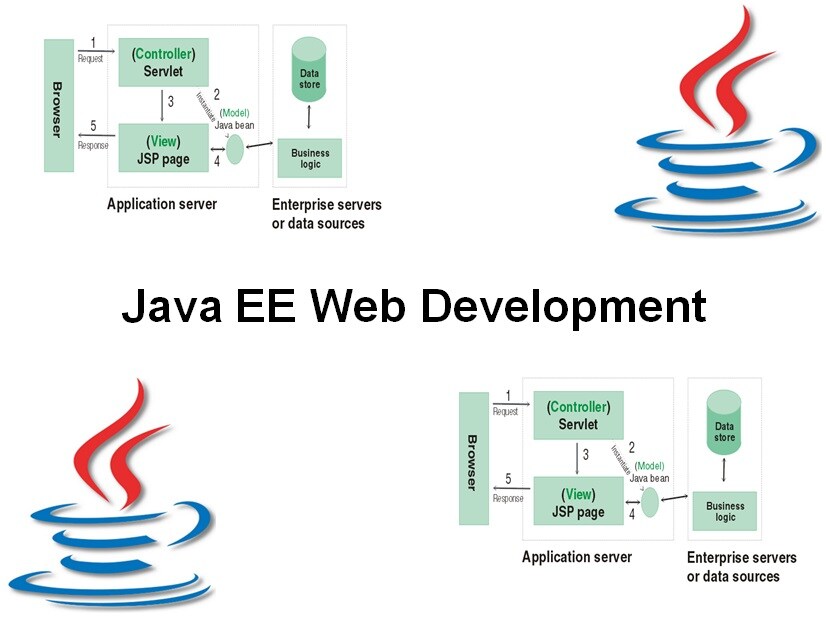- Leren door doen
- Trainers met praktijkervaring
- Klassikale trainingen
- Gedetailleerd cursusmateriaal
- Duidelijke inhoudsbeschrijving
- Maatwerk inhoud mogelijk
- Trainingen die doorgaan
- Kleine groepen
De cursus Jakarta EE Web Development behandelt hoe servlets en JSP's worden gebouwd en gebruikt in Jakarta EE Web Applications.
Eerst worden de belangrijkste methoden van servlets besproken, zoals methoden die gebruikt worden in de servlet initialisatie, bij het lezen van HTTP request data en bij het schrijven van HTTP response data.
De verschillende scopes van web applicaties zoals sessie scope en application scope worden toegelicht. Naast de basis syntax van JSP scriptlets, staan expressions en declarations op de agenda en worden de verschillende JSP page directives behandeld.
Een centraal element in de cursus is het MVC design pattern voor Java Web Applications waar servlets fungeren als controller voor program logic en JSP's als view voor output data. Bij het bespreken van dit design pattern, wordt de RequestDispatcher interface behandeld evenals de manieren waarop attributen kunnen worden opgeslagen en teruggevonden in verschillende scopes.
Ruime aandacht wordt besteed aan technieken om Java code te scheiden van het JSP view. In het bijzonder wordt het gebruik van Java beans en custom tags voor dit doel besproken.
Verder komt de rol van deployment descriptors aan bod en worden security in web applicaties, filters en het event framework besproken.
De cursus Jakarta EE Web Development is bestemd voor developers die Java Web applicaties met Jakarta EE componenten zoals Servlets, JSP's, custom tags, filters en event listeners willen bouwen.
Om aan deze cursus te kunnen deelnemen is ervaring met programmeren in Java en object oriëntatie vereist.
De theorie wordt behandeld aan de hand van presentatie slides en wordt afgewisseld met oefeningen. Demos zorgen voor een verheldering van de theorie. Alle onderwerpen die gevraagd worden op het Java Web Component Developer examen worden besproken. De cursustijden zijn van 9.30 tot 16.30.
De deelnemers krijgen na het goed doorlopen van de cursus een officieel certificaat Jakarta EE Web Development.

Module 1 : Introduction |
Module 2 : Servlets |
Module 3 : Scopes and Sessions |
|
Jakarta EE Standard Jakarta EE Servers What is a Servlet? Possible Servlet Tasks What is a Java Server Page(JSP)? Problems with Servlets and JSP Classic MVC Pattern Model 2 Architecture Structure of a Web Application Registering a Web Application Defining Custom URL's WAR Files Handling Relative URL's |
Servlet Interface Reading Initialization Parameters Concurrent Access ServletContext Interface Destroying Servlets HTTP Requests and Responses HttpServlets service, doGet and doPost Reading Form Data HTTP Request Headers Populating the Response HTTP Status Codes HTTP Response Headers |
Sharing Data with Scope Objects ServletContext Application Scope Request Scope Page Scope Session Scope Session Tracking Mechanisms Sending and Reading Cookies Session Tracking with Cookies URL Rewriting Hidden Form Fields HttpSession methods Session tracking API |
Module 4 : JSP's |
Module 5 : JSP Directives |
Module 6 : JSP Standard Actions |
| The Need for JSP Types of Scripting Elements Benefits of JSP Translation and Request Time Setting up your environment Expressions Predefined Variables Scriptlets Declarations jspInit and jspDestroy |
What are JSP directives JSP page Directive import Attribute contenttype Attribute session Attribute buffer and autoflush Attributes extends Attribute errorPage and isErrorPage include Directive taglib Directive |
jsp:include jsp:plugin, jsp:param and jsp:params What are Beans? Basic use of Beans in JSP Accessing Bean Properties Setting Bean Properties Explicitly Association with Input Parameters Sharing Beans Values of Scope Attribute Conditional Bean Operations |
Module 7 : MVC Architecture |
Module 8 : Expression Language |
Module 9 : Custom Tags |
| Why combine Servlets and JSP? MVC Approach Implementing MVC Dispatching requests Storing Data in Servlet Request Storing data in Session Storing data in ServletContext Forwarding Requests Including Requests |
Advantages Expression Language Activating Expression Language Invoking the EL Common EL Problem Referencing Scoped Variables Accessing Bean Properties Nested Beans Using EL Operators Conditional Evaluation |
What are Tag Libraries? Custom Tag Features Simple Tag Handler Simple Tag Library Descriptor Accessing Custom Tags from JSP Attributes and Body Content JSP-based Tags Tags manipulating Body Complex Objects for Attributes |
Module 10 : Security |
Module 11 : Filters |
Module 12: Event Listeners |
| Major Security Concerns Declarative Security Programmatic Security Form-based Authentication Deployment Descriptor settings BASIC Authentication Combining Security Mechanisms Pure Programmatic Security Programmatic Security with SSL |
What are Filters? Filter Interface Creating Filters doFilter method Servlet Filter Related Classes Filters in a Chain Filter Mapping Accessing the Servlet Context Filter Initialization Parameters |
Life-Cycle Events Framework Available Listeners Implementation Strategy Reason for listeners ServletContext Listeners ServletContextAttributeListeners HttpSession Listeners Session Creation Events SessionAttribute Listeners |
